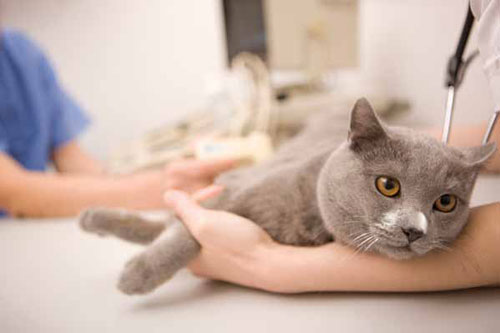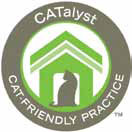Elevating cat care
The CATalyst Council, in its mission to champion the cat, has been helping make over veterinary clinics as cat-friendly practices and is seeking to bolster relations between private practitioners and animal shelters.
A coalition of veterinary organizations, shelter organizations, and other stakeholders formed CATalyst in 2008 to elevate cat health and welfare. Last year, CATalyst and the American Association of Feline Practitioners began promoting the concept of cat-friendly practices. At the same time, the council started efforts to enhance shelter-practitioner relations.
Practice makeovers
CATalyst continues spreading the word that pet cats make fewer veterinary visits than pet dogs in the United States, even though pet cats are more populous.
"They're not getting the appropriate level of care just given their nature and given the perceptions and the beliefs that pet owners have about the health care of their cat," said Dr. Alexis Nahama, CATalyst board chair and vice president for marketing for VCA Animal Hospitals.
The council has been working with ThinkPets Inc., a provider of client communications and practice analytics, on a pilot project of making over veterinary clinics as cat-friendly practices to increase veterinary visits.

To provide information for the pilot project, ThinkPets surveyed 1,800 pet owners early this year about their attitudes toward veterinary care.
The survey found that if an animal had never been to a veterinarian, it was two times as likely to be a cat as it was to be a dog. A quarter of cat owners who had not brought their cat to a veterinarian in the past year did not think a visit would improve the cat's overall health or lifespan.
A third of cat owners said they would bring their cat to a veterinarian more often if the veterinarian explained the value and importance of preventive care. More than half of cat owners said transporting their cat to the veterinarian was difficult or very difficult.
 The pilot program of cat-friendly makeovers involved 17 practices that are ThinkPets customers, said Dr. Jane E. Brunt, CATalyst executive director.
The pilot program of cat-friendly makeovers involved 17 practices that are ThinkPets customers, said Dr. Jane E. Brunt, CATalyst executive director.
Dr. Brunt said a ThinkPets consultant assisted practices in developing or refining standards for feline wellness care by referring to the Feline Life Stage Guidelines from the AAFP and American Animal Hospital Association and to materials from the United Kingdom's Feline Advisory Bureau, which pioneered the concept of cat-friendly practices.
Cats are "not getting the appropriate level of care just given their nature and given the perceptions and the beliefs that pet owners have about the health care of their cat.
Dr. Alexis Nahama, board chair, CATalyst Council
The pilot project featured 10 training webinars on cat-friendly practices and specific steps for client communication. In July, practices began sending letters with product offers and follow-up email messages to invite existing clients to bring in cats for a visit.
Comparing July 2011 with July 2010, practices in the pilot project had a 1.9 percent increase in invoices from feline patients and a 4.1 percent increase in revenues from feline patients. Among ThinkPets customers that did not participate in the cat-friendly makeovers, invoices from feline patients decreased 2.9 percent and revenues from feline patients increased just 0.2 percent, comparing July 2011 with July 2010.
Dr. Brunt said CATalyst plans to expand the cat-friendly makeover program to more practices next year.
"If we can fine-tune it and sustain it and replicate it over thousands of veterinary hospitals, it will be good for cats," Dr. Brunt said.
Shelter relations
In starting efforts to enhance the relationship between animal shelters and local practitioners, Dr. Brunt said, CATalyst facilitated a strategic alliance between the Society of Animal Welfare Administrators and the American Society of Veterinary Medical Association Executives. Now the council is developing materials to assist shelters and private practitioners in working together better at the local level.
CATalyst plans to identify communities to participate in a pilot project to implement the materials. The goals include encouraging adoption of cats from shelters and educating cat adopters about cats' needs for continuing veterinary care, beyond veterinary services that shelters provide before adoption.
"If you put things on the table and if everybody understands the big picture of their community's animal care world, then there would be opportunities to help more pets and help more people enjoy responsible pet ownership," Dr. Brunt said.
Dr. Nahama said CATalyst has talked with people in communities with good shelter-practitioner relations and in communities with poor relations. The materials for the pilot project to bolster relations include case studies of communities that have or are building good relations.
One aspect of the project is to urge people from the veterinary and shelter circles to agree on acceptable terminology—not referring to "the pound," for example. Another aspect could be to organize casual get-togethers of people from both circles in neutral environments such as dog parks.
Dr. Nahama said a common factor in communities with good shelter-practitioner relations is simply that "people know each other, people understand each other."
In addition to cat-friendly practice makeovers and efforts to enhance shelter-practitioner relations, CATalyst continues to promote feline health and welfare to the press and directly to the public. Among the council's resources for cat owners is a recently released video with five steps to reduce cats' resistance to carriers.
Resources on feline health and welfare are available at www.catalystcouncil.org.